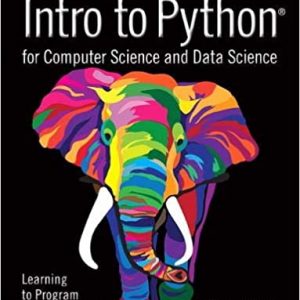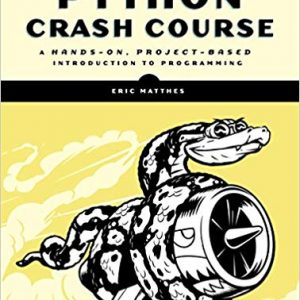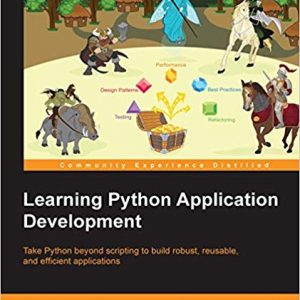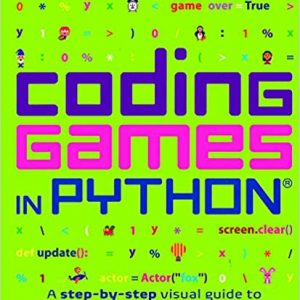Python for Programmers: with Big Data and Artificial Intelligence Case Studies (in PDF) is the professional programmer’s Deitel guide to Python with introductory artificial intelligence case studies.
Written for programmers with a background in another high-level language, this ebook uses hands-on instruction to teach today’s most compelling, leading-edge computing technologies and programming in Python – one of the world’s most fastest-growing and popular programming languages. Please read the Table of Contents diagram inside the front cover and the Preface for more details.
In the context of 500+, real-world examples ranging from individual snippets to 40 large scripts and full implementation case studies, you’ll use the interactive IPython interpreter with code in Jupyter Notebooks to quickly master the latest Python coding idioms. After covering Python Chapters 1—5 and a few key parts of Chapters 6—7, you’ll be able to handle significant portions of the hands-on introductory AI case studies in Chapters 11—16, which are loaded with cool, powerful, contemporary examples. These include natural language processing, data mining Twitter for sentiment analysis, cognitive computing with IBM Watson™, supervised machine learning with classification and regression, unsupervised machine learning with clustering, computer vision through deep learning and convolutional neural networks, deep learning with recurrent neural networks, big data with Hadoop, Spark™ and NoSQL databases, the Internet of Things and more. You’ll also work indirectly or directly with cloud-based services, including Twitter, IBM Watson, Google Translate™, OpenMapQuest, PubNub, Microsoft Azure, and more.
Features
- IPython + code in Jupyter Notebooks
- Static, interactive and dynamic visualizations
- Data experiences with real-world datasets and data sources
- Procedural, functional-style and object-oriented programming
- 500+ hands-on, real-world, live-code examples from snippets to case studies
- Collections: Lists, tuples, dictionaries, sets, NumPy arrays, pandas Series & DataFrames
- Rich Python coverage: Control statements, functions, strings, files, JSON serialization, CSV, exceptions
- Intro to Data Science sections: AI, basic stats, simulation, animation, random variables, data wrangling, regression
- Library-focused: Uses Python Standard Library and data science libraries to accomplish significant tasks with minimal code
- Open-source libraries: NumPy, pandas, Seaborn, Matplotlib, scikit-learn, SciPy, NLTK, Folium, spaCy, Textatistic, TextBlob, Tweepy, Keras and more.
- AI, big data and cloud data science case studies: NLP, IBM Watson™, machine learning, data mining Twitter, computer vision, Hadoop, deep learning, Spark™, IoT, NoSQL etc
P.S We also have the Python for Programmers test bank and other instructor resources for sale. Contact for more info
Reviews
“For a while, I have been looking for an ebook in Data Science using Python that would cover the most relevant technologies. Well, my search is over. A must-have book for any practitioner of this field. The machine learning chapter is a real winner!! The dynamic visualization is fantastic.” — Ramon Mata-Toledo, Professor, James Madison University
“I like the new combination of topics from computer science, data science, and stats. This is important for building data science programs that are more than just cobbling together math and computer science courses. A book like this may help facilitate expanding our offerings and using Python as a bridge for computer and data science topics. For a data science program that focuses on a single language (mostly), I think Python is probably the way to go.” — Lance Bryant, Shippensburg University
“Covers some of the most modern Python syntax approaches and introduces community standards for style and documentation. The machine learning chapter does a great job of walking people through the boilerplate code needed for ML in Python. The case studies accomplish this really well. The later examples are so visual. Many of the model evaluation tasks make for really good programming practice. I can see readers feeling really excited about playing with the animations.” — Elizabeth Wickes, Lecturer, School of Information Sciences, the University of Illinois at Urbana-Champaign
“A great introduction to Big Data concepts, notably Hadoop, Spark, and IoT. The examples are extremely realistic and practical. The authors do an excellent job of combining programming and data science topics. The material is presented in digestible sections accompanied by engaging interactive examples. Nearly all concepts are accompanied by a worked-out example. A comprehensive overview of object-oriented programming in Python—the use of card image graphics is sure to engage the students.” — Garrett Dancik, Eastern Connecticut State University
“An engaging, highly accessible ebook that will foster curiosity and motivate beginning data scientists to develop essential foundations in Python programming, statistics, data manipulation, working with APIs, data visualization, machine learning, cloud computing, and more. Great walkthrough of the Twitter APIs—sentiment analysis piece is very useful. I have taken several classes that cover natural language processing and this is the first time the tools and concepts have been explained so clearly. I appreciate the discussion of serialization with JSON and pickling and when to use one or the other—with an emphasis on using JSON over pickle — good to know there’s a safer, better way!” — Jamie Whitacre, Data Science Consultant
“The chapters are very clearly written with detailed explanations of the example code. The modular structure, a wide range of contemporary data science topics, and code in companion Jupyter notebooks make this a fantastic resource for readers of a variety of backgrounds. Fabulous Big Data chapter—it covers all of the relevant programs and platforms. Great Watson chapter! The chapter provides a great overview of the Watson applications. Also, your translation examples are great because they provide an ‘instant reward’—it’s very satisfying to implement a task and receive results so quickly. Machine Learning is a huge topic, and the chapter serves as a great introduction. I loved the California housing data example—very relevant for business analytics. The chapter was visually stunning.” — Alison Sanchez, Assistant Professor in Economics, University of San Diego
NOTE: Only the PDF ebook Python For Programmers is included in this purchase. No other resources are included








Reviews
There are no reviews yet.